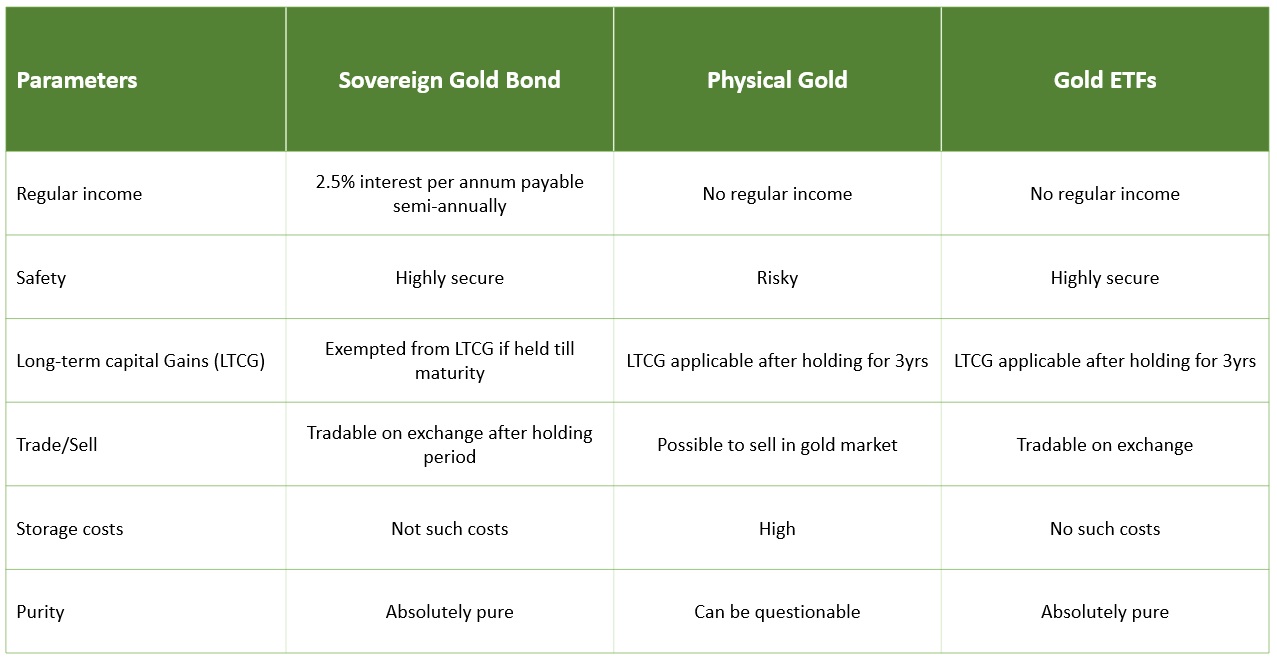The Government of India had announced the Sovereign Gold Bond Scheme 2020-21 on October 9, 2020. The sixth and final tranche of 2020-21 Series XII opens for subscription on March 1, 2021.
Salient points of the Sovereign Gold Bond Scheme
- Subscription opens on March 1 and closes on March 5
- Date of issuance of bonds is March 9
- Bonds issued by the Reserve Bank of India on behalf of the Government of India
- Resident individuals, HUFs, Trusts, Universities and Charitable institutions are eligible to purchase
- Bond tenor is 8years, with an exit option available after 5years
- Issue price fixed at Rs4,662/- per gram
- For the ones applying online or making an payment through digital mode, the price fixed at Rs4,612/- per gram
- Bonds are tradable on stock exchanges
- Nomination and cancellation is possible under the scheme
- A Non-resident Indian (NRI) may get security transferred in his/her name as a nominee on the death of the investor
- The NRI must hold the security until maturity or early redemption
- Interest and maturity proceeds of the investment are not repatriable
- The gold bonds issued in the form of Stock Certificate are transferable
Investment size and limits
The minimum investment in the Sovereign Gold Bold scheme is 1gram of gold.
The maximum investment is as per the status of the investor:
| Investor type | Maximum limit |
| Individual | 4kg |
| Hindu Undivided Family (HUF) | 4kg |
| Trusts and similar entities | 20kg |
Definitions:
- ‘Person’ and ‘Resident of India’ is as defined in the Foreign Exchange Management Act, 1999
- ‘Trusts’ are meant to describe a trust constituted/formed as per the Indian Trusts Act, 1882, or public or private trust included or recognized under the provisions of any Central or State Law
- ‘Charitable institution’ to mean a company registered under section 25 of the Indian Companies Act, 1956 or section 8 of The Companies Act, 2003 or as defined in the notification
- ‘University’ means a university established or incorporated by the Central, State or Provincial Act and includes an institution declared under section 3 of the University Grants Commission Act, 1956
The ceiling prescribed above applies to the total bonds purchased under different tranches and those purchased from the secondary market. However, the limit will not include the holding as collateral by banks and other financial institutions.
In the case of a joint holding, the limits will be applicable only for the first holder.
Interest Rate on Sovereign Gold Bonds
Investors will earn an interest rate of 2.5% per annum, payable semi-annually on the bonds’ nominal value.
The last interest shall be payable upon maturity along with the principal amount.
Taxability of interest earned from the Bonds
The interest income on gold bonds shall be taxable as per the provision of the Income Tax Act, 1961. Further, the act exempts any capital gains from Sovereign Gold Bonds’ redemption to an individual from tax. In the case of any other person, indexation benefits are available to calculate long-term capital gains.
Top 10 benefits to invest in Sovereign Gold Bonds
For the investors who would like to invest in gold, the scheme offers a few compelling benefits. Few important ones are listed below:
- No physical storage hassles like physical gold
- Digital gold, hence it is safe and secure
- Guaranteed returns of 2.5% per annum (taxable)
- Exempted from the long-term capital gains tax
- Flexibility to redeem after 5years on every interest payment date
- No GST on the sovereign gold bond purchase, unlike applicable on the purchase of gold in physical form
- Since this is a digital subscription to gold, there are no making charges
- Bonds are tradeable on stock exchanges, hence highly liquid
- It is possible to use Sovereign Gold Bonds as collateral security
Redemption will happen at market value, based on the simple average of the closing price of gold of 999 of the previous three days as published by the India Bullion and Jewellers Association (IBJA).
Comparison with other forms of gold ownership


How to apply for Sovereign Gold Bonds
You can apply for the bonds using Form A. The form clarifies grams (in units) of gold, the applicant’s full name and address. Know Your Customer (KYC) norms as applicable to the physical purchase of gold would apply here. A voter id, Aadhar card, or TAN/Passport will be required. You must furnish a PAN card copy with the application.
Who are authorized to receive the application for bonds:
- Scheduled commercial banks – List of banks
- Designated post offices
- Stock Holding Corporation of India Ltd (SHCIL)
- National Stock Exchange of India Ltd, and,
- Bombay Stock Exchange Ltd
The receiving office shall provide an acknowledgement receipt as per Form B upon receiving the application.
You can purchase the Gold Bonds by making payment in Indian rupees. A cash payment is possible up to a maximum of Rs20,000/-. All the other payment modes like a demand draft, a cheque, or electronic banking are available.
Information of past tranches under the current series
Below listed are the previous tranches of the 2021 Series.
| Tranche | Subscription date |
| 2020-21 Series VII | October 12-16, 2020 |
| 2020-21 Series VIII | November 09-13, 2020 |
| 2020-21 Series IX | December 28-January 01, 2021 |
| 2020-21 Series X | January 11-15, 2021 |
| 2020-21 Series XI | February 01-05, 2021 |
| 2020-21 Series XII | March 01-05, 2021 |
For historical information across various gold bond series, please visit the National Stock Exchange website. Here is the link for ease – https://www.nseindia.com/market-data/sovereign-gold-bond
Conclusion thoughts
Recently we have seen gold prices soar as well as a decline in a short time-frame. Pressure on the yellow metal may exist in the short-term; therefore, Sovereign Gold Bonds’ investments may remain under the weather. Given an uncertain global economic recovery pace, gold prices may continue to remain fragile. Hence, in the mid to short term, returns from gold may remain under question.
However, long-term prospects of gold remain intact. For investors looking at the mid-long term investment horizon, sovereign gold bonds are a good option. SGBs are incredibly convenient vs the traditional form of buying physical gold. Payment of interest provides a regular stream of income. Further, an additional benefit of exemption of redemption from long-term capital gains tax for the bonds held until maturity is an added advantage.
Also, do read about asset classes for portfolio diversification in my earlier article Six major asset classes for portfolio diversification.
—————————————————————–
The author is a senior finance professional with over fifteen years of work experience in corporate finance and has an affinity for personal finance and investment management. Please leave your comment or share thoughts on this article via email at decodefinance.in@gmail.com. For more articles, please visit the website www.decodefinance.in.
Disclaimer:
The author has used his knowledge, experience, and understanding of the subject to write this article. Any views, opinions, and thoughts mentioned in the article belong solely to the author and not necessarily to the author’s employer (past or current), organization, committee, or other group or individual.
Under any circumstances, the author shall not be liable for any views or analysis expressed in this note. Further, the opinions expressed are not binding on any authority or Court. We advise readers to consult their financial advisor for assistance in their specific case.





Very informative. Although I don’t understand keeping NRIs outside the purview of eligible investors.
Comprehensive information